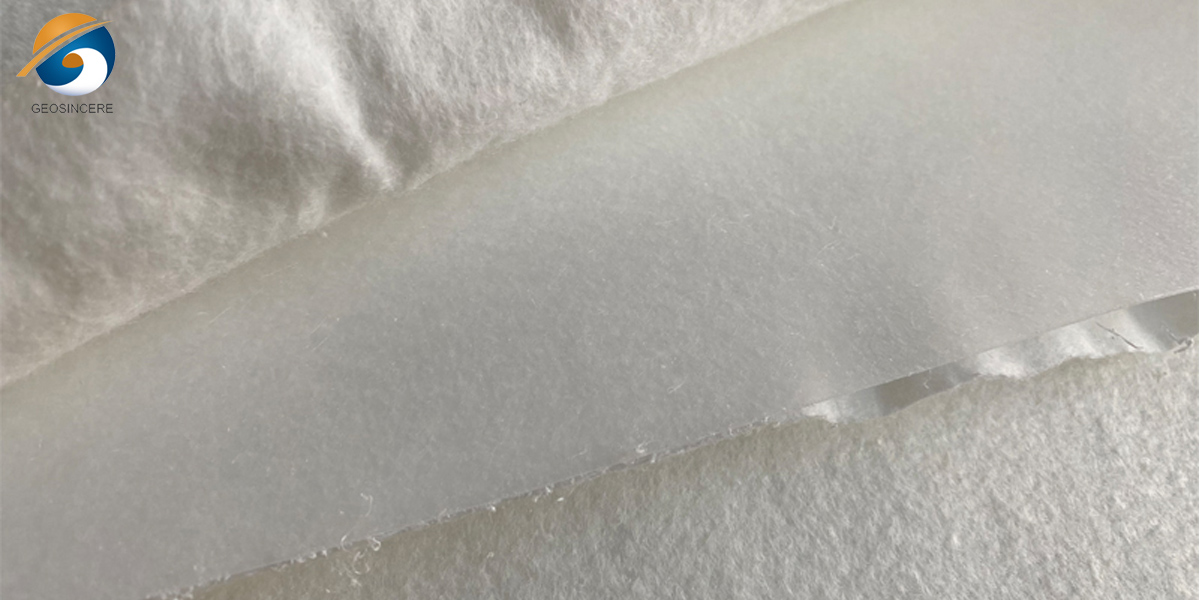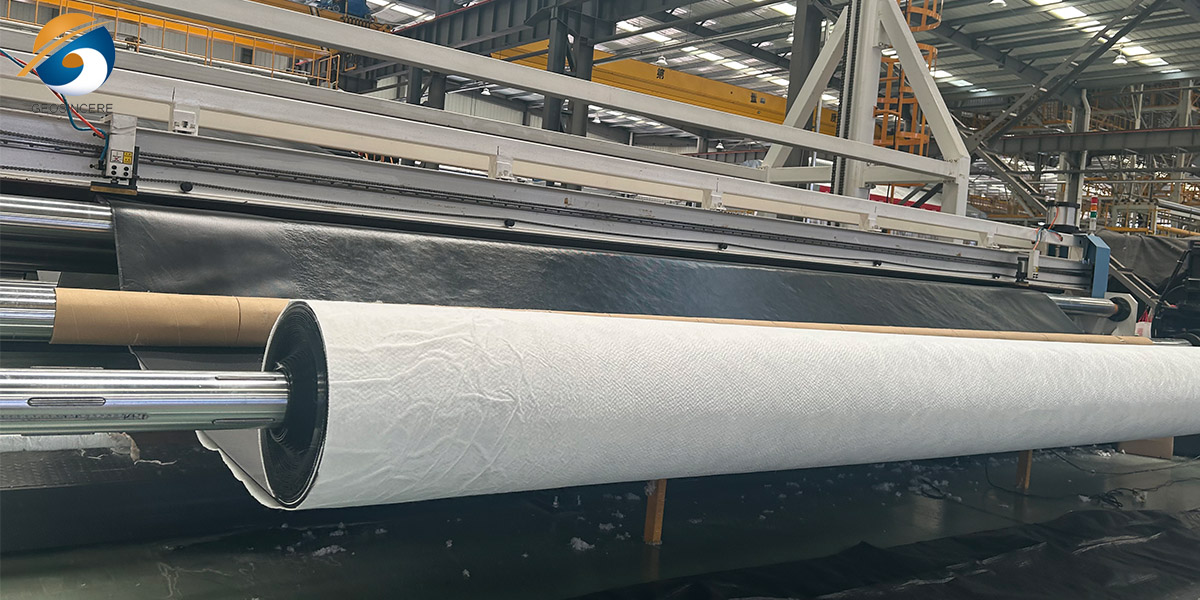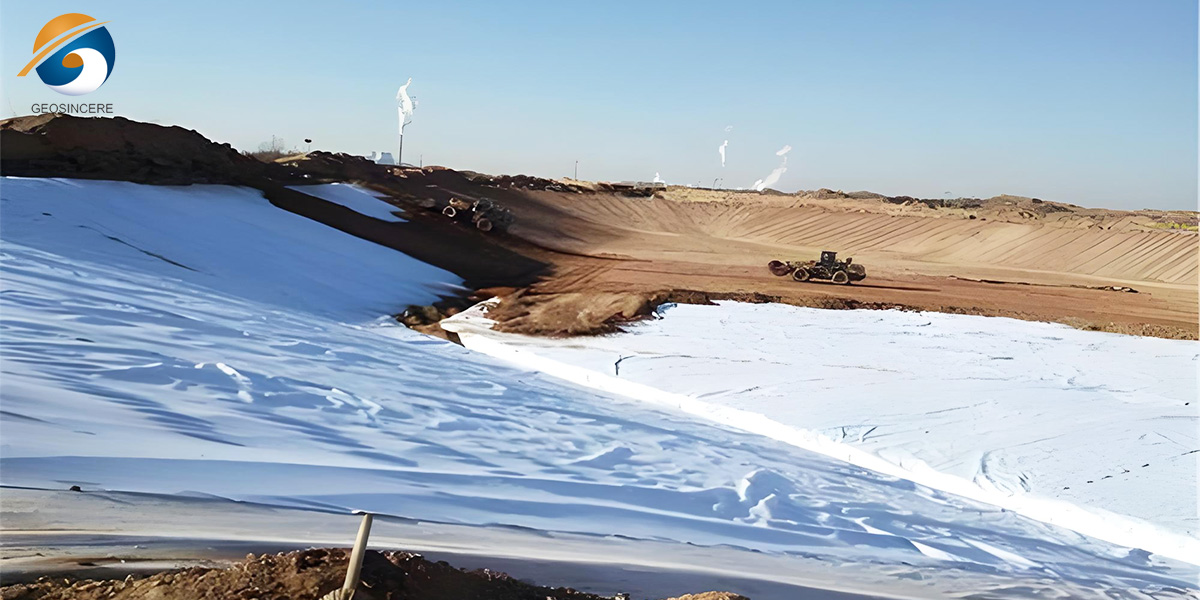The Ultimate Guide to Choosing Composite Geomembrane
In today’s water conservancy projects, environmental protection projects, transportation infrastructure, and mining engineering, composite geomembrane has become an indispensable anti-seepage material. Whether it is a reservoir dam, landfill, canal, tunnel, highway, or railway project, composite geomembrane provides long-term stability for projects with its superior anti-seepage performance and mechanical strength.
However, when facing different thicknesses, structures, and materials of composite geomembrane, many buyers, contractors, and engineering designers often encounter doubts: How to choose the right composite geomembrane?
As a foreign trade enterprise deeply engaged in the geosynthetics field, GEOSINCERE Geosynthetics will provide you with a detailed analysis of the types, applications, selection points, and procurement details of composite geomembrane from a professional perspective, helping you make scientific decisions in your projects.
1. Definition and Basic Structure of Composite Geomembrane
Composite geomembrane is made of geomembrane (such as HDPE, LDPE, LLDPE, or PVC polymer materials) and geotextile (such as polyester or polypropylene needle-punched nonwoven fabric) mixed via thermal bonding or adhesive lamination. This shape offers it twin.
1.1 Composite Geomembrane Functions:
Anti-seepage function: The geomembrane layer efficaciously prevents the penetration of liquid or gas, defending the surroundings from pollution.
Reinforcement and filtration function: The geotextile layer presents mechanical strength, enhances soil stability, and approves water to skip via whilst keeping soil particles, stopping clogging.
1.2 Common composite types include:
- One material one film: One layer of geotextile + one layer of geomembrane.
- Two fabric one film: One layer of geomembrane sandwiched between - two layers of geotextile.
- Multi-layer composites: Multiple fabric-film buildings can be stacked to beautify standard performance.
This “fabric-film combination” shape permits composite geomembrane to withstand exterior mechanical harm whilst preserving splendid anti-seepage overall performance all through construction.
2. Main Performance Advantages of Composite Geomembrane
2.1 Excellent anti-seepage performance
The geomembrane layer is normally made of HDPE, LDPE, or PVC, with extraordinarily low permeability, efficaciously blocking off water, oil, and chemical solutions.
2.2 Good mechanical properties
The geotextile layer offers excessive tensile strength, tear resistance, and abrasion resistance, making the composite geomembrane liner much less in all likelihood to be broken all through transport and installation.
2.3 Chemical resistance
Particularly appropriate for landfills, tailings ponds, and different complicated environments, resisting acid, alkali, and natural substances.
2.4 Aging resistance and long service life
With antioxidant and UV resistance treatment, composite geomembrane can be used outdoors for more than 20 years.
2.5 Easy construction
High flexibility makes it easier to adapt to irregular terrain, reducing welding difficulty and improving efficiency.
3. Application Fields of Composite Geomembrane
Composite geomembranes are versatile substances broadly used in engineering tasks that demand stringent anti-seepage performance. Their purposes span a couple of industries, supplying dependable safety in opposition to water loss, soil contamination, and structural damage. Key software fields include:
3.1 Composite Geomembrane for Water Conservancy Projects
- Reservoirs and Dams: Prevent water seepage, beautify storage efficiency, and defend dam structures.
- Canals and Water Channels: Control leakage alongside irrigation and drainage systems.
- Farmland Irrigation Ponds and Water Storage Tanks: Reduce water loss, improve irrigation efficiency, and keep sustainable agricultural water management.
3.2 Composite Geomembrane for Environmental Protection Projects
- Landfill Bottom Liners and Cover Systems: Provide impermeable obstacles to forestall leachate infection of soil and groundwater.
- Municipal Wastewater Treatment Ponds: Ensure containment of handled and untreated wastewater, defending surrounding environments.
- Industrial Wastewater Regulating Ponds: Safely shop and manipulate industrial effluents, decreasing environmental risks.
3.3 Composite Geomembrane for Transportation Engineering
- Highway Subgrade Reinforcement and Drainage Protection: Prevent water infiltration, hold roadbed stability, and prolong pavement life.
- Railway Subgrade Isolation and Reinforcement: Enhance basis stability, manipulate groundwater impact, and minimize upkeep needs.
3.4 Composite Geomembrane for Energy and Mining Engineering
- Coal Mine Sedimentation Ponds: Contain mining runoff and stop soil and water pollution.
- Tailings Pond Liners: Provide secure containment of mining tailings, decreasing environmental hazards.
- Oil and Gas Tank Anti-Seepage Systems: Protect soil and groundwater from leakage of hazardous petroleum products.
3.5 Composite Geomembrane for Agriculture and Fishery
- Artificial Lakes and Aquaculture Ponds: Maintain water satisfactory and forestall leakage in fish farming operations.
- Agricultural Water Storage and Irrigation Canals: Improve water retention effectivity and make certain dependable irrigation for crops.
4. Key Factors in Choosing Composite Geomembrane
4.1 Clarify challenge requirements: software eventualities decide selection
Different functions require extraordinary cloth properties:
4.1.1 Landfills and hazardous waste containment: Require extraordinarily excessive impermeability and chemical resistance. HDPE-based composite geomembranes are desired due to most efficient chemical resistance and long-term durability. Thickness is commonly above 1.5mm and should meet strict environmental policies such as EPA standards.
4.1.2 Artificial lakes, reservoirs, and ponds: Anti-seepage is critical, whilst the chemical surroundings is distinctly mild. LLDPE or PVC-based composite geomembranes may additionally be greater budget friendly and simpler to install. UV-resistant variations are endorsed for long-term exposure.
4.1.3 Tunnels and underground projects: Require now not solely anti-seepage however additionally mechanical electricity and puncture resistance. Two-fabric-one-film constructions grant higher safety towards sharp rocks.
4.1.4 Highway and railway subgrades: Mainly used for separation, reinforcement, and drainage. The geotextile layer’s power is crucial—choose excessive tensile energy needle-punched nonwoven composites to enhance soil stability.
4.2 Material characteristics: polymer and geotextile selection
4.2.1 Geomembrane layer polymer:
- HDPE: High strength, great impermeability, chemical resistance, and UV stability. Less flexible, now not perfect for irregular terrain. Thickness tiers from 0.5mm–3.0mm, appropriate for harsh environments.
- LDPE/LLDPE: More flexible, less difficult to install, precise impermeability however decrease chemical resistance and energy than HDPE. Suitable for medium-risk tasks such as agricultural ponds.
- PVC: Excellent flexibility, effortless welding, however plasticizer migration may additionally motive long-term aging. Suitable for non permanent or brief projects.
- Others (e.g., EPDM): Used in exceptional ecological functions due to environmental friendliness.
4.2.2 Geotextile layer:
- Polyester (PET): High strength, excessive modulus, heat-resistant however weaker in alkali resistance. Suitable for most soils.
- Polypropylene (PP): Strong acid/alkali resistance, however UV degradation risk—requires stabilizers. Cost-effective for common reinforcement.
- Structure & weight: Needle-punched nonwoven presents higher filtration and drainage, whilst woven cloth affords greater strength. Weight normally stages 200–600 g/m².
The bonding approach (thermal bonding or adhesive) additionally impacts standard performance. Thermal bonding ensures more suitable adhesion, appropriate for high-strength applications.
4.3 Environmental and chemical factors: make certain long-term durability
4.3.1 Chemical exposure: Soil or liquid pH, oils, solvents, acids, or alkalis may also degrade materials. HDPE resists most chemicals, whilst PVC may also soften in natural solvents. Conduct chemical compatibility trying out if necessary.
4.3.2 UV exposure: For long-term out of doors projects, pick substances with carbon black or UV stabilizers to forestall polymer embrittlement.
4.3.3 Temperature range: Extreme warmth or bloodless influences flexibility and welding. HDPE can also come to be brittle in low temperatures, whilst LLDPE performs better.
4.3.4 Biological threats: Microbes or root intrusion. Select anti-root variations for greening areas.
Conduct web site assessments and request accelerated getting older check records to make sure carrier existence suits challenge expectations (20–100 years).
5. Composite Geomembrane vs. Single Geomembrane/Geotextile
- Single geomembrane: Excellent anti-seepage however susceptible puncture and abrasion resistance, without difficulty broken at some stage in construction.
- Single geotextile: Strong mechanical overall performance however terrible impermeability, can't be used by myself for seepage control.
- Composite geomembrane: Combines each advantages—anti-seepage and harm resistance—making it the top of the line choice.
6. Composite Geomembrane Construction and Welding Essentials
- Base preparation: Remove sharp objects, maintain floor flat.
- Laying sequence: From low to excessive areas to keep away from stress concentration.
- Welding process: Hot-melt welding is most common; make sure seam tightness.
- Quality inspection: Includes appearance check, vacuum test, ultrasonic test.
- Cover and protection: In landfills or reservoirs, cowl soil on pinnacle of the membrane to forestall UV and exterior damage.
7. Composite Geomembrane FAQ (Frequently Asked Questions)
Q1: What is the carrier lifestyles of composite geomembrane?
A: Normally 15–25 years, and longer for top rate products.
Q2: Is composite geomembrane environmentally friendly?
A: Yes. HDPE, LDPE, and comparable polymers are eco-friendly and do no longer purpose secondary soil or water pollution.
Q3: Can composite geomembrane be used in excessive or low temperatures?
A: High-quality HDPE composites work between -60℃ and +60℃, appropriate for most climates.
Q4: How to verify first-class when purchasing?
A: Request third-party take a look at reports, ISO certification, and mission references.
8. Procurement Composite Geomembrane Considerations
Define undertaking requirements: pick out thickness and fabric-film structure.
- Choose dependable suppliers: with export experience, pleasant certification, and undertaking references.
- Check welding carrier support: suitable suppliers provide set up coaching and technical support.
- Calculate logistics costs: reflect onconsideration on container loading and transport for bulk exports.
- Contract details: specify product specifications, first-class standards, trying out methods, and after-sales service.
9. GEOSINCERE Geosynthetics’s Solutions
As one of China’s main geosynthetics suppliers, GEOSINO has over 15 years of manufacturing and export experience. Our composite geomembranes are exported to Southeast Asia, the Middle East, Africa, South America, and more, extensively used in water conservancy, environmental protection, transportation, and electricity projects.
Our benefits include:
Wide product vary (0.3mm–2.0mm thickness, 100–600 g/m² material weight)
Advanced manufacturing strains making sure robust bonding and uniform thickness
Strict fantastic checking out assembly ISO, CE, SGS standards
Professional overseas change crew offering one-stop procurement and logistics services
Whether you are a contractor, format institute, or distributor, GEOSINO affords reasonably priced composite geomembrane solutions.
10. Conclusion
Choosing the proper composite geomembrane is no longer solely about anti-seepage overall performance however additionally at once impacts challenge balance and operational safety. By comprehensively thinking about mission purpose, thickness, structure, uncooked materials, and building conditions, you will locate the most appropriate solution.
If you are searching for a dependable composite geomembrane supplier, sense free to contact Shandong Geosino New Material Co., Ltd. (GEOSINCERE Geosynthetics)’s overseas change team. We will grant expert consultation, personalized solutions, and international logistics services.
Contact us these days for the brand new citation and technical support!








